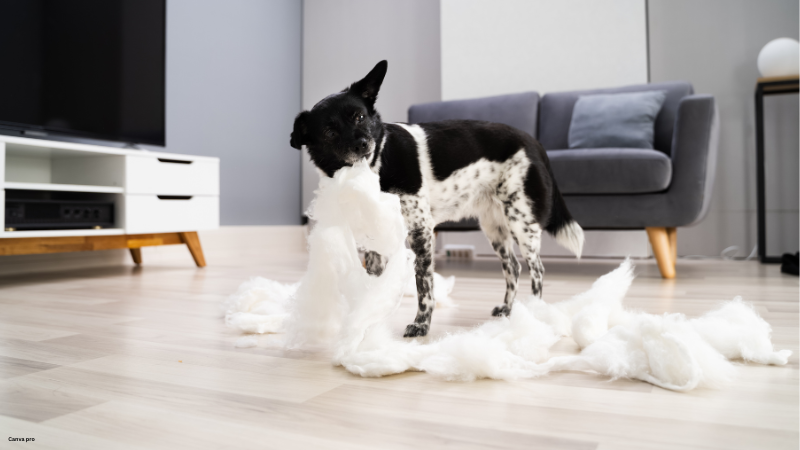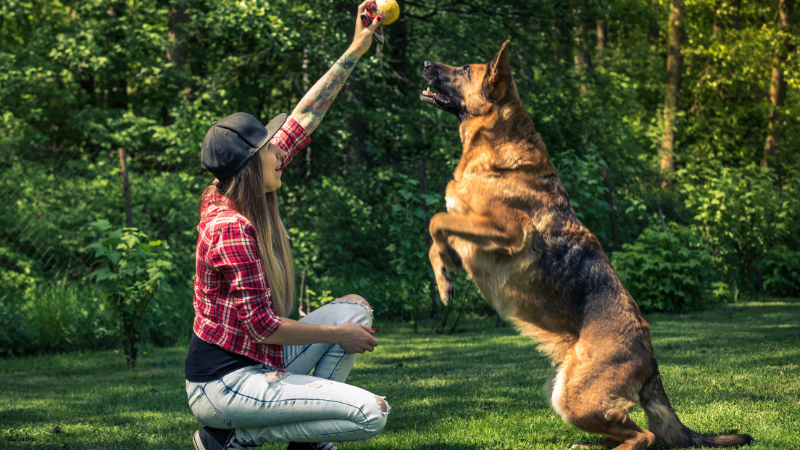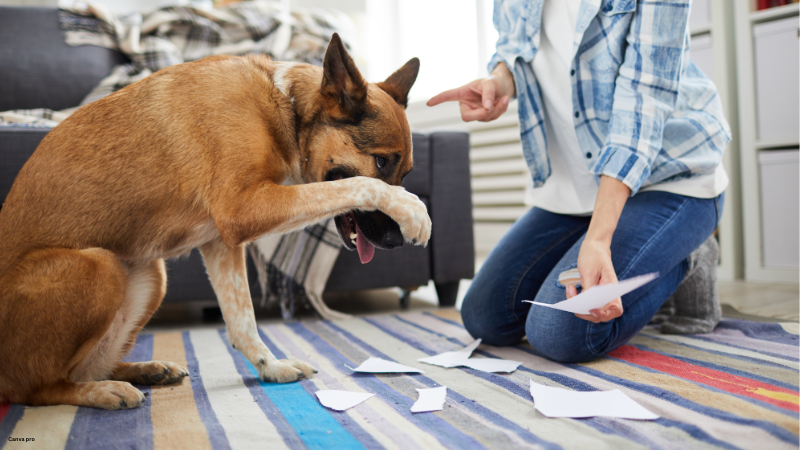Dogs don’t misbehave out of spite. Learn the reasons behind their actions and explore effective, humane strategies using positive reinforcement to curb dog’s unwanted behaviors.
Dog’s Unwanted Behaviors requires learning humane and effective strategies to address them. Are you struggling with your dog’s unwanted behavior? Feeling lost and unsure what to do?
Before we dive into effective strategies for curbing dog’s unwanted behaviors, we must understand that dogs don’t misbehave to annoy us.
Despite popular belief, dogs don’t act out “spitefully” or try to dominate us when they misbehave.
Dr. Amy Pike, a board-certified veterinary behaviorist, explains, “No species in the animal kingdom form dominance hierarchies with another species.”
When dogs don’t follow commands, we must look beyond the myth of dominant hierarchies and consider more likely reasons, such as confusion about what we’re asking, anxiety, or distractions.
It’s also worth noting that many behaviors humans find problematic – like digging, barking, chewing, nipping, and jumping – are natural dog behaviors.
Often, dogs exhibiting “bad behaviors” haven’t been properly trained and haven’t learned what we’d prefer them to do instead.
Keeping these points in mind, let’s explore several strategies to reduce unwanted dog behaviors without resorting to harmful, punishment-based training techniques.
1. Avoid Bad Advice
Unfortunately, many dog owners searching for ways to stop bad behaviors come across advice that’s not only ineffective but potentially harmful in the long run.
It might be tempting to physically correct your dog to stop bad behavior and vent your frustration. However, these methods often backfire.
A year-long study of dog owners using confrontational methods to address destructive behaviors found that such approaches rarely fix the problem and can even trigger aggressive responses!
So, avoid advice suggesting physical corrections like hitting, kicking, shaking, staring down, alpha rolls, or scruff shakes – these risk provoking aggression in your dog.
Even seemingly harmless corrections like forcibly removing an item from the dog’s mouth or staring them down can lead to aggressive reactions.
2. Don’t Fall Into the “No” Trap
Many dog owners instinctively say “no” whenever their dog misbehaves. As verbal creatures, it’s hard to resist expressing our displeasure with this common word. However, experts discourage using “no” with dogs and children.
The main problem with saying “no” is that it doesn’t teach dogs or children what we want them to do instead.
Moreover, many “bad” dog behaviors stem from a need for attention. Saying “no” to attention-seeking dogs still counts as attention, even if hostile.
3. Act Before Bad Behavior Escalates
It’s important to stop bad behavior early. As the saying goes, “nip it in the bud.”
If you notice that wild look in your puppy’s eye right before they grab your pant leg to bite, intervene immediately. You’ll have a better chance of redirecting the puppy’s nipping before they latch on and shake vigorously.
Just before they attach is a great time to wave a flirt pole, toss a ball in the opposite direction, or scatter some kibble (always keep some handy in your pocket or treat bag) to redirect their attention.
Addressing problematic behaviors early is crucial to prevent them from becoming habits. If you allow a dog to repeat a problematic behavior repeatedly, it becomes more deeply ingrained and harder to eliminate than if you address it right away.
The lesson? Address problematic behaviors as soon as they appear to minimize their chances of becoming ingrained habits.

Photo credit: Canva Pro
Recognizing the Purpose of Your Dog’s Actions
Behavior is simply what any living creature does. As noted earlier, many dog behaviors we label “problematic” are normal and natural for canines. Dogs dig, bark, and seek food – it’s in their nature.
Dogs exhibiting “bad” behavior are often untrained and have yet to learn to manage their impulses, similar to children who have yet to learn proper manners.
The Impact of Reinforcement
Behavior doesn’t occur in isolation; there’s usually a reason behind it. If a dog continues undesirable behavior, it’s likely being reinforced somehow. Dogs typically engage in “bad” behaviors for two main reasons: to obtain something desirable or to avoid something unpleasant.
Obtaining Something Desirable
The dog performs a specific action to gain access to something it wants or to fulfill an internal need (e.g., jumping on counters for food, barking for attention, digging to find underground creatures).
Any behavior that allows your dog to access something it desires, thus providing a positive outcome, will be strengthened and repeated. This demonstrates the power of positive reinforcement.
Avoiding Something Unpleasant
In this scenario, the dog engages in a particular behavior to escape or avoid an uncomfortable situation (e.g., fleeing during bath time, hiding when scared, biting when someone tries to put on a collar, growling when children attempt to pick them up). Any behavior that enables your dog to avoid an unpleasant situation will be reinforced and repeated. This illustrates the power of negative reinforcement.
Issues with Misinterpretation
Understanding the exact purpose of a dog’s problematic behavior can help pinpoint the most effective strategy for addressing it.
This is why behavior experts rely on functional behavior assessments and analysis. Once the precise function of a behavior is clear, the most effective interventions to reduce its occurrence can be developed.
For instance, a client of mine was frustrated with her Labrador’s barking when she returned from work. The barking annoyed her and her neighbors. She assumed her dog was angry about being left behind and seeking “revenge.” Her neighbor suggested using a water gun to stop the barking, as it had worked for her Yorkie.
My client tried this approach but came to me desperate when her dog’s barking intensified and became higher-pitched, even when sprayed with water!
Observing the situation, I saw a dog enjoying the water and barking to encourage more spraying!
Labradors are known for their love of water, so this dog was barking excitedly to express a desire to play. She was reinforcing the behavior by spraying him for barking rather than discouraging it!
Moreover, had she recognized that Labrador’s initial barking was attention-seeking, a different, more effective approach could have been implemented.
The water spray provided a double reinforcement: the enjoyment of water and the attention received. No wonder the barking increased!
Here’s another example: Joe the beagle growls when guests pat his head. The owner started putting him in a time-out area every time he growled. Yet, the growling persisted visit after visit.
Joe likely growls because visitors are uncomfortable touching him, so the time-out actually provides relief. By using time-outs, the owner is inadvertently reinforcing the growling!
Utilize Management to Prevent Repetition
Whether you seek professional help (more on this later) or address the issue yourself, it’s crucial to prevent the problem behavior from being repeated (through management). At the same time, you develop a behavior modification strategy. Use management techniques when you can’t actively work on the issue.
Management involves taking steps to prevent the behavior from occurring or at least to prevent it from escalating to a more intense form.
For instance, if your dog leaps on visitors to your home, you could temporarily install a baby gate when guests arrive to prevent this behavior. Similarly, if your dog tends to steal food from counters while you’re cooking, keep him out of the kitchen until he learns better manners.
Prepare Your Dog for Success
Understanding your dog’s behavior is key to modifying unwanted habits. If you can anticipate when problematic behavior is likely to occur, you can take preventive measures and set your dog up for success.
I’m always pleased when dog owners tell me, “Every time I do X, my dog does Y. How can I change this?” This pattern allows us to predict the behavior, giving us more control.
Recently, a new puppy owner contacted me about her puppy’s excessive evening biting. She had tried various methods to tire the puppy out, including walks, interactive toys, fetch, and training sessions. Despite these efforts, the puppy would consistently start nipping aggressively around the same time each evening.
The solution was simple: the puppy was overtired! Like toddlers, puppies need restorative sleep and can become irritable when exhausted.
We resolved the issue by establishing an earlier bedtime and creating a quiet, calming space for the puppy to rest.
Reduce the Impact of Triggers
It is crucial to keep your dog below its reaction threshold by minimizing trigger intensity. For example, if your dog barks at other dogs during walks, increasing the distance between them can help reduce the barking as the trigger becomes less prominent.
Another example: If your dog steals food from countertops, place items back out of easy reach.
The goal is to modify the environment in a way that is likely to alter the problematic behavior.
You can record the triggering noise for dogs that react to doorbells or other sounds and play it at a low volume that doesn’t cause a reaction. Gradually increase the volume while pairing the sound with treats to create positive associations.
Progress Gradually
As dog owners, we often expect quick results and risk advancing too rapidly in training.
Animal trainer Bob Bailey advises, “Be a splitter, not a lumper.” This means breaking training goals into small, manageable steps rather than taking large leaps. This approach helps your dog succeed.
For instance, if your puppy cries when left alone in a crate, don’t expect immediate comfort with overnight separation. Instead, start with brief absences, like leaving the room for a few seconds, and gradually increase the duration. These small steps help desensitize your puppy.
Desensitization is a behavior modification technique where the dog is systematically exposed to triggers or uncomfortable situations at a level that doesn’t cause distress.
Occasionally mix shorter absences with longer ones to prevent your puppy from anticipating increasing difficulty.
Monitor progress closely. If your puppy struggles with a one-minute absence, it’s a sign to return to shorter durations until he’s comfortable.
Remember, slow and steady progress is key in behavior modification!

Photo credit: Canva Pro
Foster Positive Associations To Check Dog’s Unwanted Behaviors
Along with gradual progress, creating positive associations can be beneficial. For example, offer a delicious treat when leaving your puppy in the crate. This teaches him that good things happen during your absence.
If he refuses the treatment, it shows excessive stress, indicating you’re moving too fast.
Counterconditioning creates positive associations that change a dog’s emotional response. It’s most effective with desensitization (gradual, low-level exposures).
Over time, as your puppy associates your departure with treats, he may shift from dreading your absence to anticipating it as a predictor of rewards.
This approach can be applied to other issues, like dogs barking at other dogs due to unease. Offering a treat each time your dog sees another dog, as in the look at the dog game can help change his emotional response.
Teach an Alternative Behavior
Once you’ve identified the dog’s unwanted behavior’s function, teach an alternative. What would you prefer your dog do instead of the problematic behavior?
For instance, a Labrador barking for attention could be trained to perform an alternative behavior for attention (e.g., hand targeting or a trick). In contrast, barking is prevented and ignored to reduce reinforcement.
Over time, as the alternative behavior is reinforced and barking is ignored, you should see an increase in the desired behavior. This method is called differential reinforcement of alternative behavior (DRA).
It’s often easier to use an alternative behavior already in the dog’s repertoire – a behavior the dog can already perform that can replace the undesirable one.
For example, if a dog knows how to sit, he can be asked to sit before his food bowl is lowered instead of jumping on the owner at mealtime.

Photo credit: Canva Pro
Track Your Progress
With consistent application of your behavior plan, you should see steady improvement. Keep a record of this progress. You should notice gradual improvement in dog’s unwanted behaviors.
You might observe your puppy playing more with a special toy instead of constantly biting your leg. Or your dog may not bark as loudly when passing other dogs. Or perhaps he’s pulling less on the leash.
If you don’t see improvement despite your efforts, or if progress stalls after initial success, step back and reassess. Have a troubleshooting plan ready to identify the issue.
Take a Holistic Approach
Changing a dog’s unwanted behavior requires considering all aspects of his life. Evaluate your dog’s overall situation.
For instance, a dog who never walks will likely be full of energy, making it hard for him to focus when his body needs to release that pent-up energy.
If your dog is stressed by constant noise or lacks rest due to kids, he may become anxious, leading to behavior problems. Dogs need daily naps and must learn to relax.
Dogs require physical and mental stimulation for their well-being. In addition to exercise, walks, socialization, and training, it’s crucial to provide mental challenges to keep their minds active. This doesn’t mean complex puzzles but rather simple activities like food puzzles, and brain games, which can be as tiring as physical exercise.
13. Rule Out Medical Issues
Sometimes, dog’s unwanted behaviors labeled as “bad” may stem from underlying health problems.
Be particularly alert if your previously well-behaved dog suddenly starts growling when petted or begins stealing food and raiding trash cans.
A dog growling when touched might be suffering from an ear infection, or another painful condition that is making it irritable.
Sudden food theft or trash raiding could indicate disorders that increase appetite, such as Cushing’s disease or diabetes, or might be a side effect of certain medications, like steroids.
Recent research has also shown that allergies can trigger behavior changes in dogs emphasizing the importance of considering physical health.
It’s crucial to rule out medical conditions before implementing a behavioral intervention plan to avoid unnecessary stress for the dog and owner.
14. Seek Professional Help For Dog’s Unwanted Behaviors
For dog’s Unwanted behavior problems, consulting a board-certified veterinary behaviorist or a certified applied animal behaviorist is recommended.
Note: Unless the behavior professional has a doctorate-level degree, they should use terms like “behavior consultant,” “behavior counselor,” or “behavior specialist” rather than “behaviorist.”
If working with a dog trainer or behavior consultant, ensure they use positive, humane behavior modification techniques.
Addressing your dog’s problematic behavior doesn’t have to be a struggle. You can guide your dog toward better behavior patterns by understanding the reasons behind their actions and using dog-friendly, positive reinforcement methods.
Patience and consistency are key; don’t hesitate to seek professional help. This can save time and reduce frustration. Addressing behavior issues early is crucial to prevent them from becoming deeply ingrained habits that are harder to change.
Remember, dogs don’t misbehave out of spite. Like children, they need gentle guidance and training to understand our expectations.
Source:
Adrienne Farricelli (July 6, 2024). 14 Ways to Stop Bad Dog Behaviors. PetHelpful. https://pethelpful.com/dogs/The-Best-Ways-to-Stop-Bad-Dog-Behaviors. Accessed July 17, 2024
Other posts you might like:
Finding Your Perfect Pup: Navigating Breeds and Lifestyles with the AKC’s Top Picks of 2024
